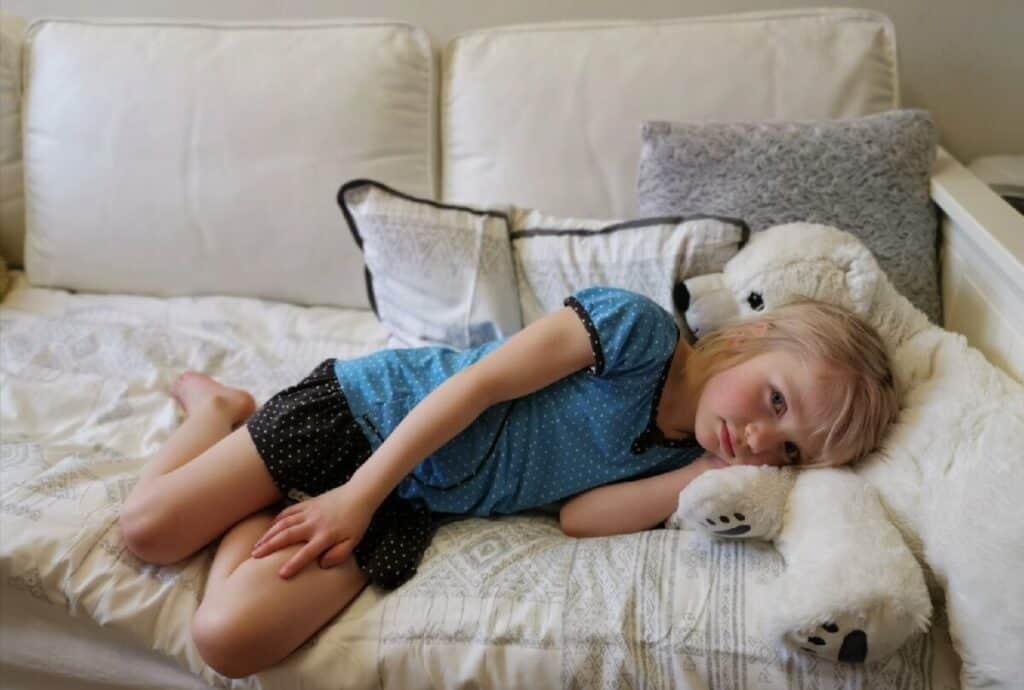
Why would you want to create a minimalistic, monochrome bedroom for your child?
A Minimalist, Monochrome bedroom promotes calmness and gives your brain a break from having to register objects and colors.
This can be a good solution for adults and children who are hypersensitive, or who have been diagnosed with ADHD predominantly hyper, ADHD predominantly inattentive, or autism.
Having a minimalist monochrome room helped my daughter, Maria (who has been diagnosed with ADHD predominantly inattentive) to feel calmer, pick up her room, to concentrate better, and stay organized.
If you want to read more about how simply redecorating my daughter’s bedroom changed the way she functions in her room click here. https://theadhdminimalist.com/a-monochrome-bedroom-decreased-my-daughters-stress-and-adhd/
The key to optimizing your child’s bedroom and creating a calming environment is to use one color in the entire room and to hide all the toys, clothes, books, games, and other paraphernalia behind closed doors. Nothing should be on shelves unless it’s aesthetic. This promotes calmness for children whose senses are easily overstimulated.
I have been asked many times, ‘’Won’t one color feel boring?’’ I don’t find it boring in my daughter’s room. As soon as she gets out toys or books there is an instant splash of color!
A minimalistic, monochrome bedroom has yet another benefit. If you live in a small house it makes your rooms feel larger than they actually are!
https://www.youtube.com/watch?v=2lD6_6j9pjU
1, brainstorm ideas about your bedroom
We looked at pictures of Kim Kardashian’s daughter North’s pink room and decided that having one main color in the room was a good idea.
My daughter, not being your average girly girl, is not fond of pink. My suggestion was pastel green because she always liked green, but Maria insisted that her room should be white!
Part of me inwardly groaned when she picked white, but I knew that it would be much easier to use white because it’s a standard color for just about anything you need to buy.
2, Make a mood board
with samples of wallpaper, paint, and material you plan to use in the room. That way you don’t have to guess if your choices match. I didn’t have time to make a mood board before we needed to start, so I had to play it by ear.
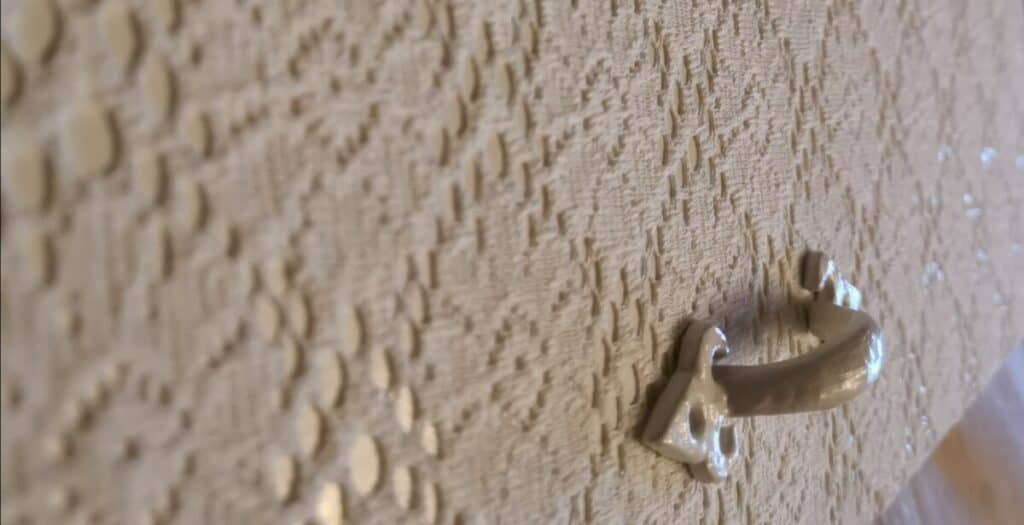
3, Incorporate texture into your monochrome design to avoid a stale environment.
White can feel rather like a hospital or an office building.
In my effort to avoid a cold environment I ordered a graphic wallpaper with a white-on-grey-white textured pattern and tried to combine traditional white with cream tones and the grey-white of the wallpaper.
Texture is extremely important in a monochrome room!
Once we got the textured wallpaper up and the trim painted I still needed several more textures to give the room a cozy feel. I reused some of my daughter’s fluffy pillows and threw imitation sheepskins on the floor.
My next idea was to add texture to some old kitchen cabinets which would replace the wardrobe. I decided to cover them in white lace.
I added even more texture by reusing a front panel that I salvaged off an old piano as a picture.
This panel did not have any wood carvings that are usually found on old pianos, so I ordered wood carvings that we glued on to create more texture.
This wooden picture was a good solution in my daughter’s room because she climbed on everything in her old room and broke her mirror and a picture frame in the process. She can’t possibly break the wooden piano panel/picture.
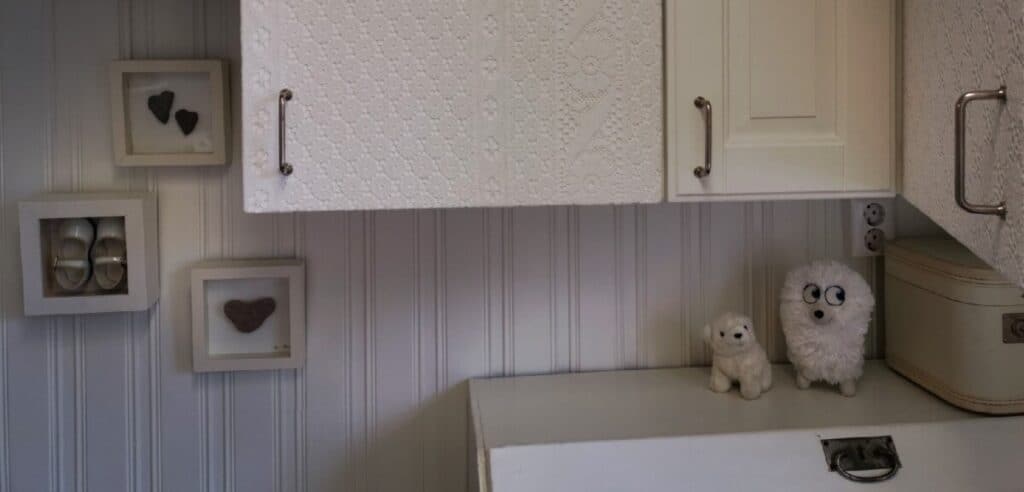
4, Incorporating your child’s baby clothes or baby shoes into the room design promotes limbic bonding. Limbic Bonding improves ADHD, but every child needs it!
When children look at their own baby clothes oxytocin is released in their brain.
If you have a child who is really hard to connect with or who always seems to be a bit edgy, one of the best things you can do to reconnect with your child is to tell them stories about when they were a baby or show them baby clothes and baby pictures.
This is something you should try to naturally incorporate into your day. Having something on display in your child’s room will give you something to look at and talk about together without having to run to the storage room.
‘’Limbic bonding is actually taking your child in and making him feel delicious. Getting that oxytocin flowing… these moments of connection are medicinal!’’ Jennifer Kolari
https://www.youtube.com/watch?v=uFckNenV-QE
https://www.youtube.com/watch?v=q28IrZq14hk&t=4444s
My daughter’s first baby shoes were extremely small and when I showed them to Maria she insisted on having them in her bedroom.
Maria wanted to enter the world early. If she had decided to come just one day earlier she would have been considered premature.
Her shoes which are proudly framed and mounted on the wall remind me to talk to her about when she was a baby. They prompt me to tell her baby stories when I tuck her in at bedtime. They help us bond.
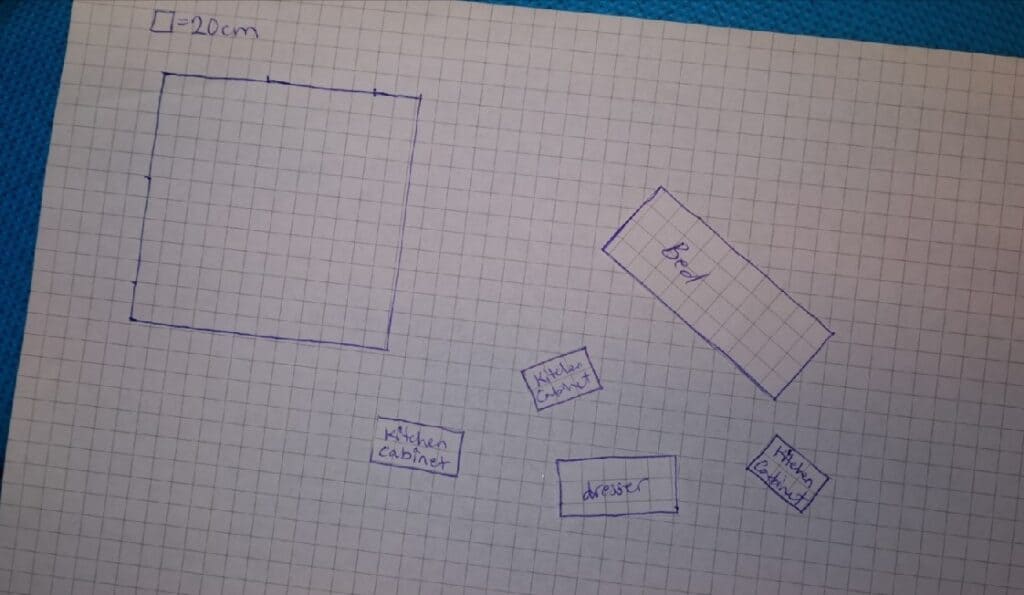
5, Plan how the furniture will sit in the room.
If you have time you can make a drawing of the room on graph paper.
You just need to make four lines to represent the walls.
Then you can measure the size of the furniture and draw them as seen from above on a separate piece of graph paper. Write the name of each piece of furniture on the shape and cut them out.
You can move the pieces around inside your room to see how they fit best. There are computer programs for this, but using graph paper is fast and easy.
If you like figuring new things out on the computer that may be a great solution for you.
We made a trade with my husband’s sister and became the proud owners of a used Ikea bed with three big drawers underneath.
Why we waste so much space under our beds I will never understand. If you live in a small house like we do every inch counts!
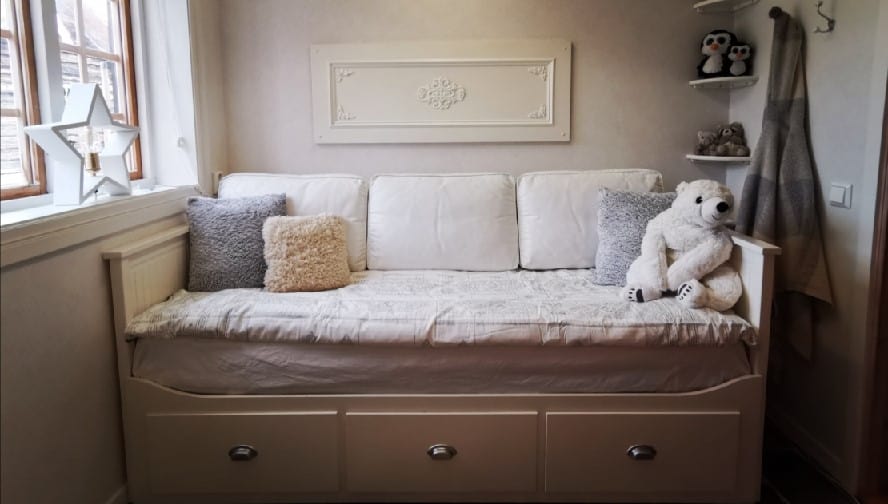
I had to think through several different ideas until I came up with the one that worked best.
I had a fixed idea that the bed should be across the back of the room. I had planned for the extra space at the foot of the bed by taking into account the dimensions of the bed I thought we were going to purchase.
When David’s sister suddenly had a bed they didn’t need, which was slightly different from the original bed, I had to scrap my plan and start from scratch.
I had a similar problem with the kitchen cabinets we planned to put on one wall.
I drew a picture of how I wanted David to put them up, but when we were about to put the last cabinet up I felt it made the sitting area claustrophobic.
The room looks much better because I scraped the last cabinet. Planning can save you a lot of building time, but you have to be flexible enough to make a few last-minute changes.
Putting the bed on a different wall was much better than my original idea. Don’t be afraid to look at things from all angles and say goodbye to any fixed ideas.
Often when we are surprised by how things turn out and we think it’s better than we could have planned it in the first place.
Ask friends and family to give their opinion of how to furnish the room. Often the opinions of others help us think outside the box.
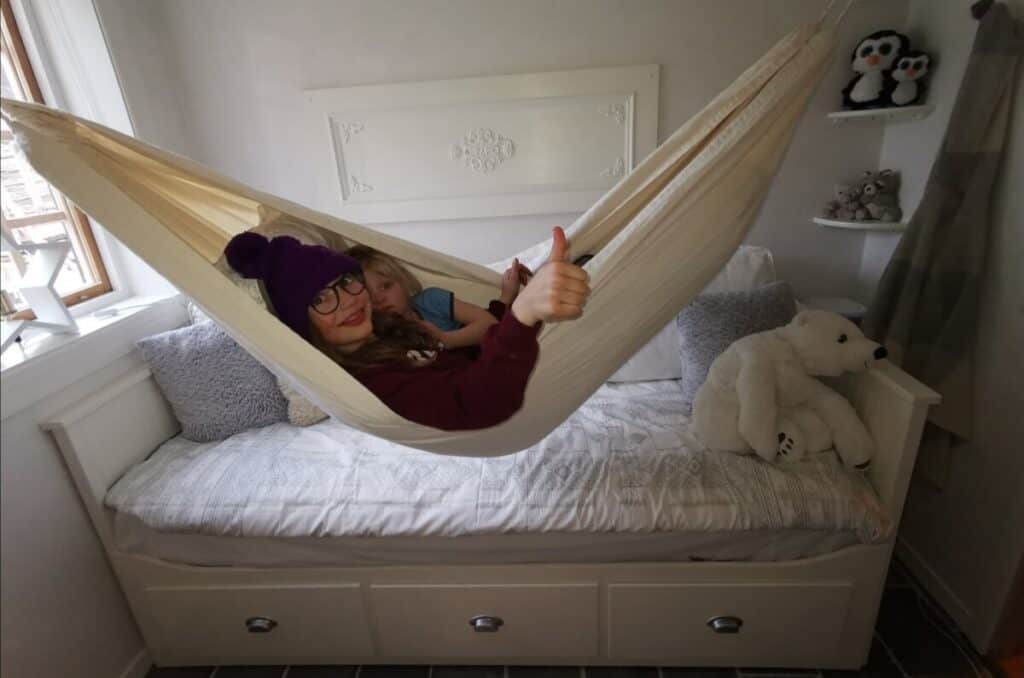
6, Get rid of stuff you don’t need! Decluttering helps ADHD. Don’t skip this step!
You won’t know how much storage space you actually need until you get rid of the things that no longer serve a purpose.
Take a good look through your child’s things when they are not home, or through your things when you can get a babysitter for the day.
This will help you get started without being interrupted every fifteen minutes.
If you have an older child you may want to invite them to help you go through clothes and toys.
I included my 10-year-old daughter as much as possible when we renovated her room.
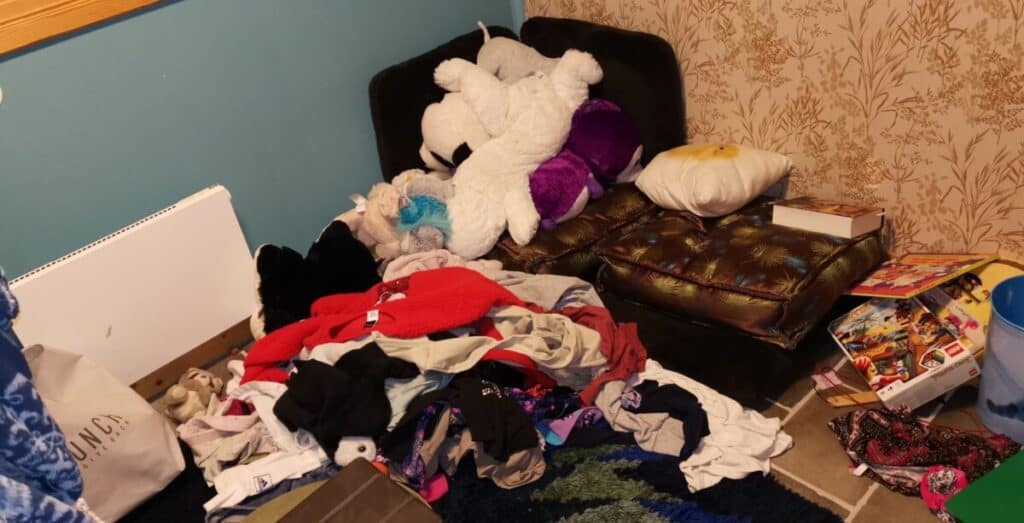
- I suggest first getting rid of all clothes that are outgrown and stained. Then take away clothes that have not been worn in the last three months.
- Throw away all McDonalds toys. Throw away all dirt cheap toys they may contain lead! When testing for lead in children’s toys, lead was found in toys from several different chain stores that are known for being extremely cheap.
Lead was found in toys, at these types of stores, all over the United States! In other words, you get what you pay for. Don’t risk it! Throw these toys away!
Lead can aggravate ADHD symptoms and make them worse. Lead can cause dementia in adults, and even seizures if you ingest large amounts.
The crazy thing is that lead was banned from paint in Most of Europe and in the United States, but most countries do not regulate lead imported on painted toys and household goods from china. You get what you pay for. If you’re not sure if it’s safe get rid of it.
- Get rid of any toys that are outgrown.
- Pack up toys that have not been played with for the last three months.
- Simplify your toys. Try keeping only four categories of toys in your child’s room, for example Legos, Barbies, Hot Wheels, and Pet Shops.
Rotate the toys if you have more categories that you want to keep. Have a couple of bins in the storage room that your child can trade for a bin in his/her room when she gets bored of the toys she has been playing with.
Make a family rule only to have four kinds of toys in the child’s room at a time.
I have noticed that my kids play with their toys more if they have less to choose from. My children are also more likely to pick up their toys if they have less to sort and to pick up.
- Go through craft supplies. Try simplifying them, so they are easier to use. I strongly suggest moving the crafts out of your child’s bedroom.
If you have another space in your house that can serve as a creative station take the chaos of crafts out of your kid’s rooms.
- Get rid of stuffed animals that never see the light of day.
- Make a place for rock collections or sticks and other outdoor things like shells outside. These things could possibly live in the playhouse or treehouse or on the balcony.
If you are not sure if your child will ask for some of these items. Keep them in the storage room for three months and give your child what he asks for.
Don’t let him see what you kept!!! Whenever he remembers something is missing from his room, he can have it back. After three months promptly get rid of the rest.
Get rid of furniture in your child’s room that they have outgrown or that is hindering them from keeping order.
For example, get rid of a dresser if your child can’t get the drawers to open and shut easily. Get rid of standard bookcases because kids often have trouble putting things back on bookcases and most kids do not have a floor-to-ceiling collection of books.
Discard as much as you can and start with a clean slate and a minimalist perspective.
Your goal should be to keep the number of new things coming into the room in check, so the storage spaces do not overflow again in the near future.
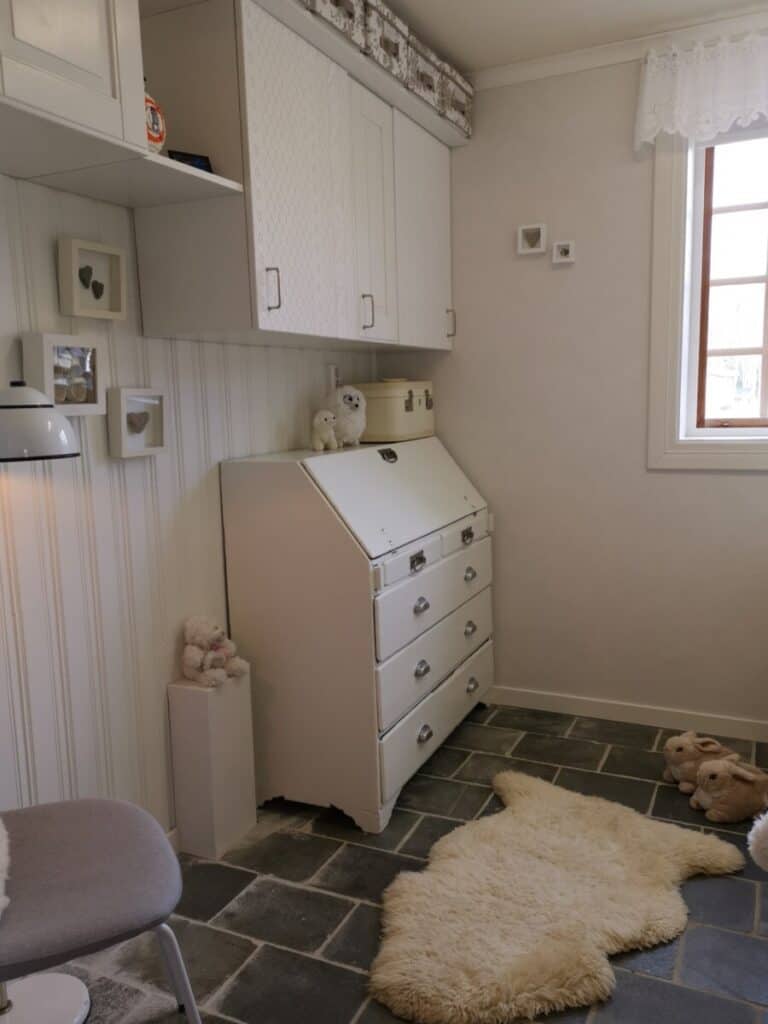
7, Plan your storage and how to organize your things in the monochrome room
It’s important to discard before you plan your storage.
Storage is important in any bedroom, but especially in children’s rooms because they have everything in their rooms from toys to homework.
You should plan your storage after you are done discarding. Plan enough space for all your things, and leave 10% of the storage space empty. The extra space serves two purposes.
- It will hinder you from buying new things.
According to Marie Kondo leaving your drawers or closets half empty causes you to unconsciously want to buy more things and fill the unused space.
Often if we keep dressers or wardrobes that we don’t actually need we will buy things to fill the empty furniture even if we have promised ourselves not to.
- We all tend to accumulate new things.
It’s good to adopt a one item in one item out rule, but there will undoubtedly be a few exceptions to this rule over time. Thus the extra space. It’s enough space for a few new things without tricking your mind into going on a shopping spree!
If you can’t fit all your things into a reasonable amount of storage furniture. Then you should try getting rid of more stuff.
Trying to cram too many things into a child’s bedroom (or your own) only teaches your family to be packrats.
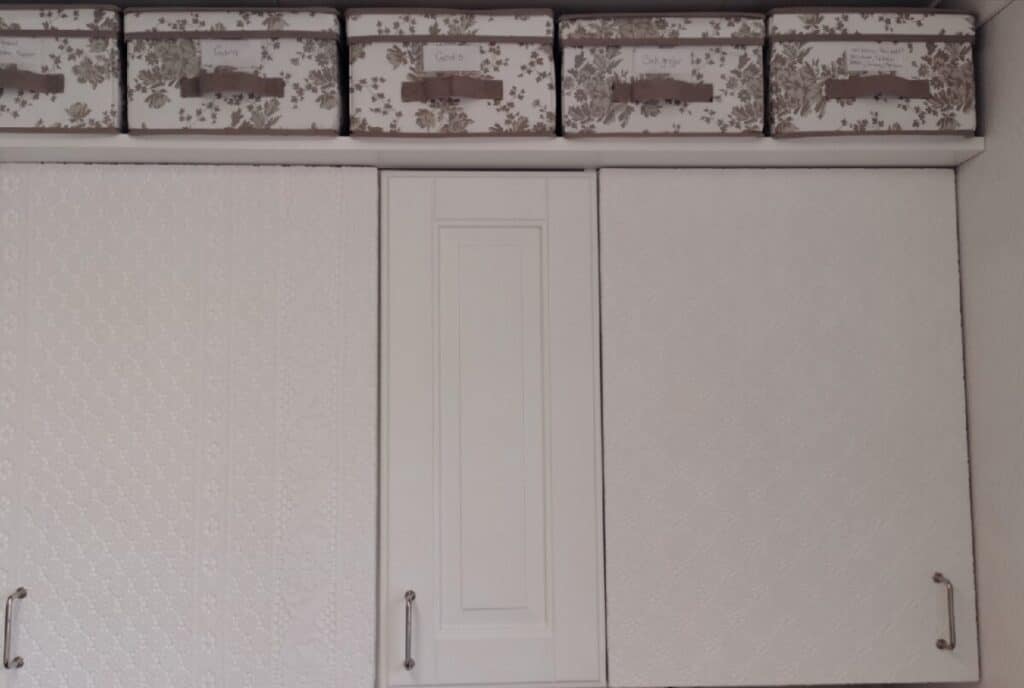
8, The storage system that helped my daughter with her ADHD
Your welcome to borrow the system my daughter and I came up with.
She was having a terrible time keeping any sort of order in her room. Because she has ADHD it was extremely hard for her to remember where things went especially when we never labeled any of her storage bins.
Having a shelf with storage boxes where my daughter could sort her toys, crafts, nail polish, and other items turned out to be the storage solution she needed.
She could read what was in each box which helped her remember where to put things back.
If you have a smaller child who can not read try drawing pictures or taking and developing pictures of what is inside and taping it on the front.
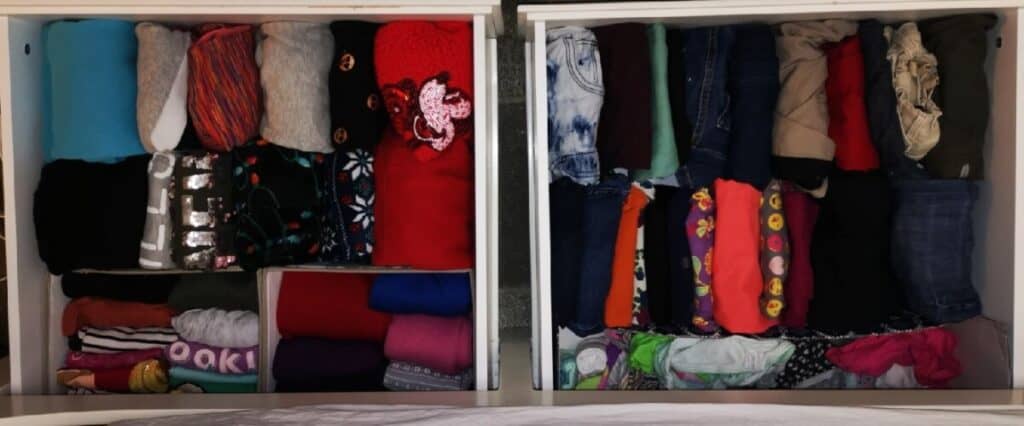
9, Store clothing standing up to help ADHD
All my daughters’ clothes fit under her new bed.
That freed up the rest of the storage space for toys, books, crafts, her violin, and homework items.
Maria has such a little room that I decided she doesn’t need anywhere to hang clothes.
She has two hooks where she hangs sweatshirts she plans to wear again before washing and her bathrobe, but other than that she doesn’t hang any clothes in her room.
Hanging clothes takes up at least twice as much space as folding them.
If you have a small house try folding as many clothes as possible. I like to fold Marie Kondo style, so all the clothes stand up.
This seems to save space and I like being able to easily see what I have in my wardrobe.
I started folding my daughter’s clothes the same way. This made a huge difference for Maria who has ADHD.
She used to pull half of her clothes out of her drawers every morning when she was trying to find a specific item of clothing to wear to school.
She would randomly pull clothes out of several drawers and leave them in a pile on the floor usually mixed with her dirty clothes from the night before!
To see how to fold clothes Marie Kondo style in an illustrated guide click here. https://theadhdminimalist.com/the-best-way-to-fold-clothes-for-adhd-kids/
As soon as I started folding her clothes, so she could see everything, she quit pulling everything out because she could now find what she was looking for easily.
Most homes have some built-in closet space in the bedrooms where you can hang clothes. Some dresses and other dressy clothes need to be hung.
My oldest daughter is a Tomboy and doesn’t like wearing dresses, so I hung the two dresses she owns for Easter and Christmas with my clothes.
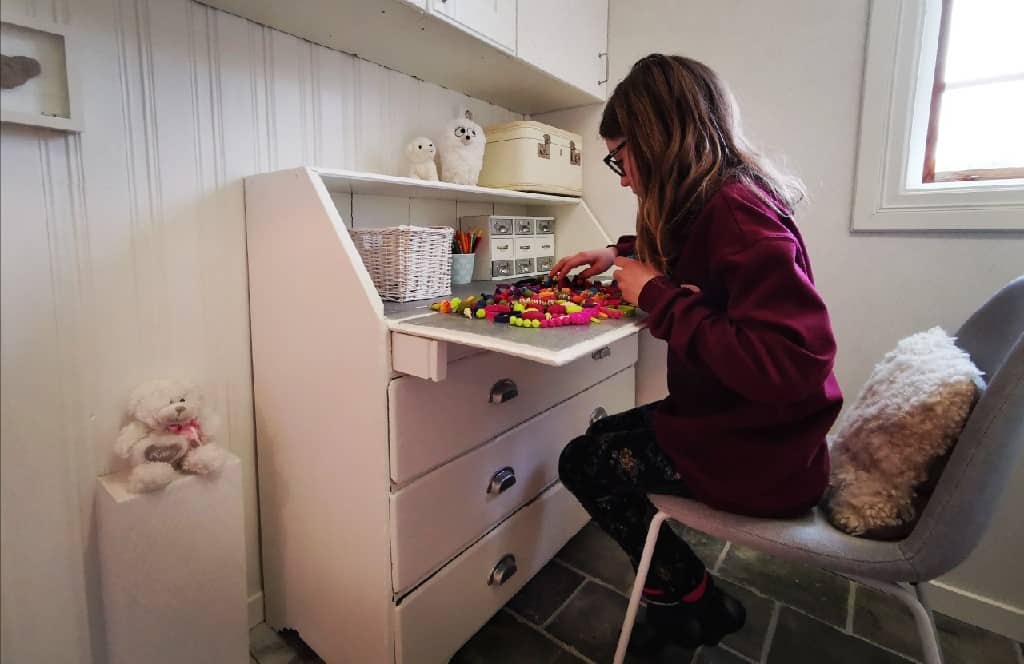
10, Secretary desks provide great storage and promote calmness for kids who have ADHD
The next piece of storage furniture we decided to use was a 100-year-old desk that had been sitting in our storage room.
In Swedish, you call this type of desk a sekretär which comes from French and means secret.
The storage capacity of such desks is phenomenal. The one we have has two small drawers and three massive drawers. It does double duty as a desk and a dresser.
I was excited to use this particular secretary desk for my daughter because
I read in a couple of books (which I can unfortunately not remember the names of and can’t find on google.) that you should not have a desk in a child’s room (especially if they have ADHD) because it causes stress.
The fact that the top of the desk is rarely cleaned off makes children feel that their homework, or other projects, are never done.
You would have to clean off the top of the desk every evening to create a calm environment for sleep.
My solution to this problem is a ‘’sekretär’’ or secretary desk.
My daughter needs to have a desk in her room because there is nowhere else she can have her desk in our small house.
When Maria is ready for bed she can fold the desk back up and she doesn’t need to look at her unfinished homework.
If you can’t get a hold of a desk that does double duty you can build one out of an old dresser.
To read a ‘How To’ guide for building a Secretary desk from a dresser. Click below. https://theadhdminimalist.com/the-best-desk-for-an-adhd-child-how-to-make-your-own-a-helpful-illustrated-guide/
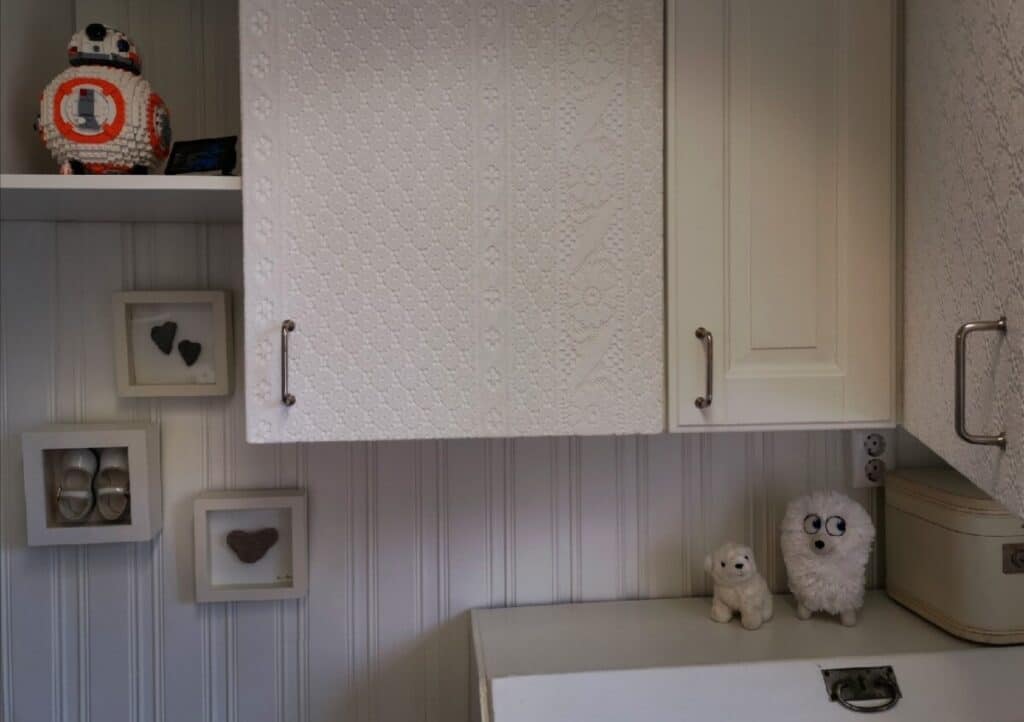
11, In a small houses use alternatives to traditional wardrobes to save floor space.
We had several old kitchen cabinets laying around the storage shed which we decided to use instead of a closet.
We did some DIY on the cabinets to make them fun to have in the bedroom before we hung them up.
For an illustrated guide on how to cover doors with lace click below. https://theadhdminimalist.com/diy-kitchen-cupboards-with-lace-as-in-my-daughters-bedroom/
Avoiding the traditional Swedish wardrobe-closet which is a piece of furniture that sits in the room, not a walk-in closet, saved a whole square meter of floor space!
Hanging the storage on the walls kept the floor clear so Maria actually had some space to play in her incredibly small room 2.35m x 2.43m or 7.7ft x 7.97ft.
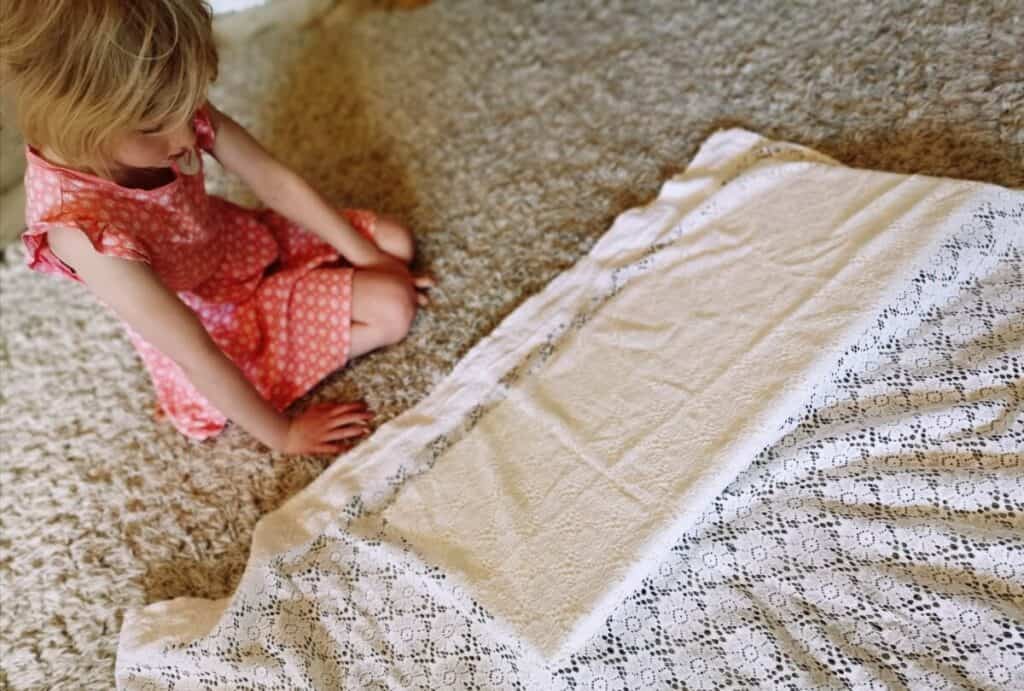
5 DIY Projects for your monochrome rooms
Upcycling kitchen cabinets
I decided to wrap two of the cabinet doors with lace to upgrade the boring standard white kitchen cabinets from Ikea.
I found lace that had bigger holes in the pattern and I was able to poke the door handle through the lace without cutting it, and staple it on the inside of the doors.
Because I wanted to use as many different textures as possible I picked two different white lace patterns one for each door.
The rest of the cabinets I found in the shed had wooden doors with a shaker-inspired pattern. They already had texture, they just needed painting.
For an illustrated guide on how to cover doors with lace click below. https://theadhdminimalist.com/diy-kitchen-cupboards-with-lace-as-in-my-daughters-bedroom/

Upcycling an old piano
The next project was to use the front panel salvaged from an old piano as a picture.
The old piano didn’t have any of the fun wooden decorations on it that you usually see on old pianos so I decided to order decorative wooden pieces that I could glue on.
I picked one big decoration for the middle and smaller decorations for the corners. There were 100s of wooden items to choose from. You could buy wooden decorations for nearly any style.
We measured where each piece should be so they were all the same distance from each other, marked the spot with a pencil, and glued them down.
We had to put weights on the decorations to make sure that all parts had contact with the wooden panel. Wood has a life of its own and isn’t always completely flat.
When the glue was dry we painted the panel which was originally black and decorations in the same shade of white.
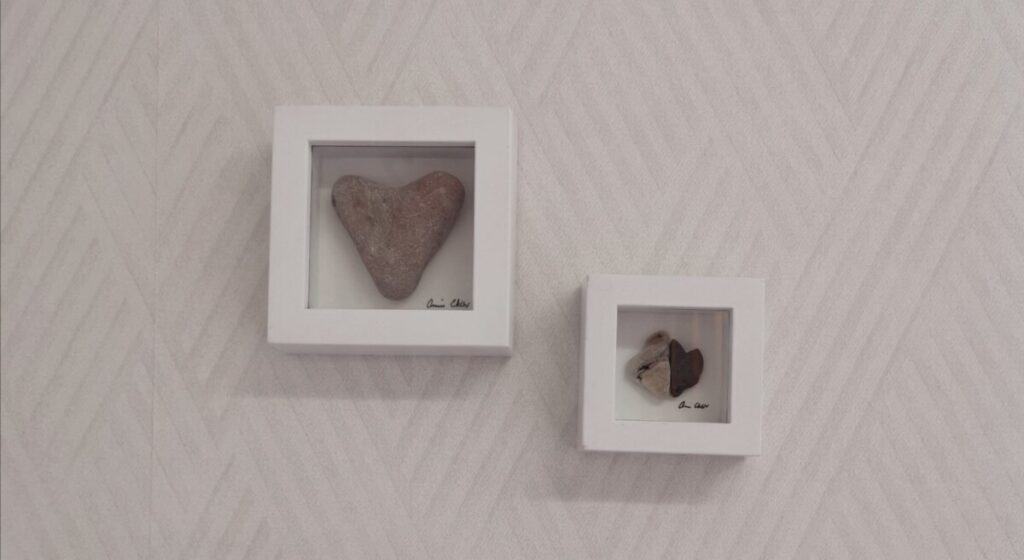
Making shadow boxes
Whenever we went to the beach I would look for heart-shaped rocks. When I had quite a few laying around I began making pictures out of them.
A couple of white shadow boxes from the craft store made great frames. I glued the pale gray rocks on a white mat with heavy-duty glue from the hardware store.
I bought a sheet of mat that was not yet cut from a hobby store to use as the back of the picture. I cut it to the right size to fit in the frame and glued the rock on it.
I had fun arranging the rocks in the frames. Some frames had only one rock, others had several.
I grouped these rock pictures together with the shadow box of my daughter’s first baby shoes and hung them on the walls.
These shadow boxes added interest to the room. With their white backgrounds and white frames and white or pale grey content, they added layers to the room without adding much color.
You can use shadow boxes to display baby clothes your child wore on the way home from the hospital or like we did display his/her first shoes.
Kids, especially girls, like to look at baby clothes, but even my son wanted to have his baby blanket in his room for a couple of years after I dug it out of the storage room to show it to him.
Maria thinks it’s fun to have her first baby shoes in her room. They are so small they usually get a reaction from her friends.
Even her sister Frida was born too big to wear Maria’s baby shoes.
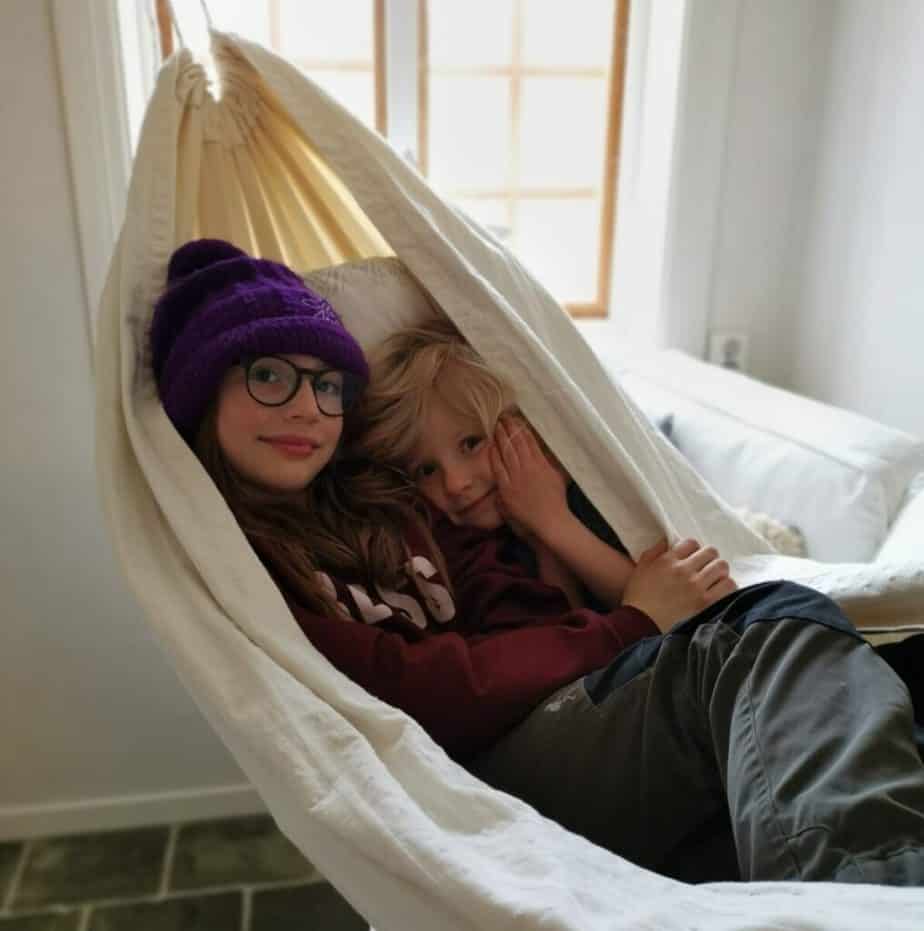
DIY a Hammock for your bedroom
My daughter wanted a hammock in her room, and I had trouble finding one that was the right size and white.
I ended up sewing a hammock myself.
- I cut two thick pieces of material into rectangles 2 meters by 1.3 meters.
- Pin the edges together.
- Sew the two sturdy pieces of material together on all sides.
- fold the short ends around a rope forming a tube and sew it down.
- Make sure you sew several different seams where the material holds the most weight. This makes the seam stronger and keeps it from breaking.
- Make a knot at the ends of the rope.
- Hang the hammock up. Use the correct hooks to avoid a crash.
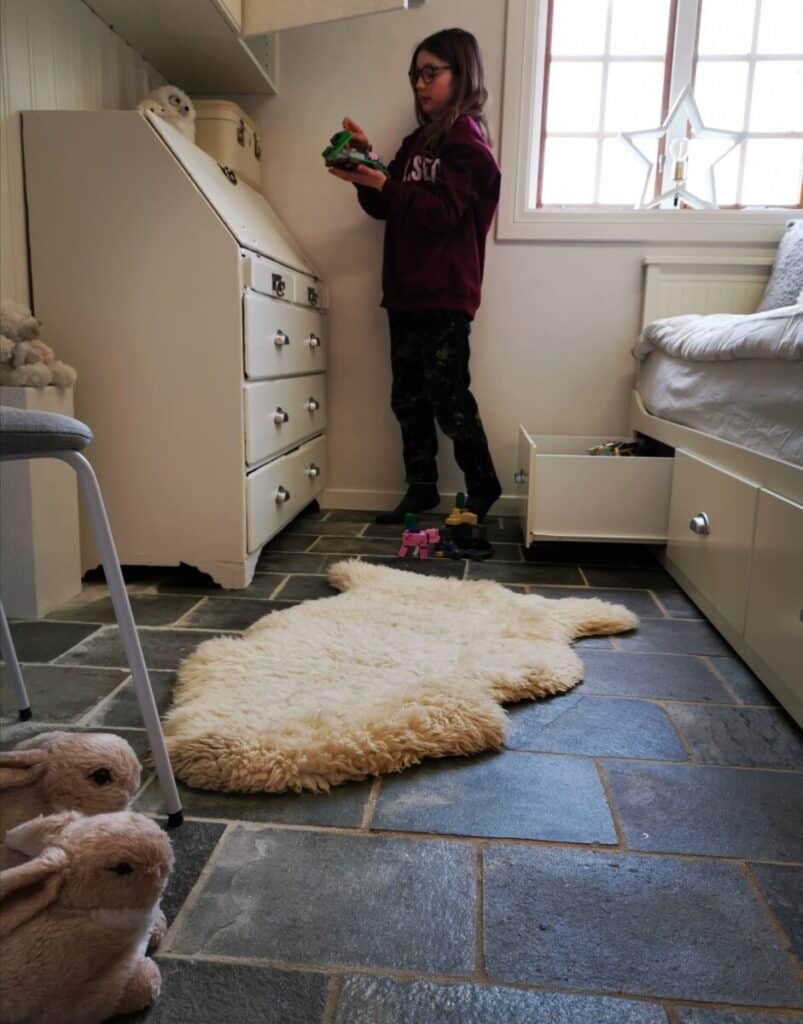
Adding a few details
I decided not to paint the chrome handles on the Ikea cabinets white. This did not seem practical because the paint would probably peel off.
I did not want to buy new ones because the ones we had looked really good and we were decorating on a budget.
The door handles inspired me to buy silver glitter paint and paint the inside of her secretary desk with silver glitter.
The room is very monochrome when the desk is shut. When you open the desk it looks like the inside is grey or silver. It’s not until you get really close that you notice its glitter. I guess this was my way of putting my stamp on her otherwise all-white room.
I decided to hang one black and white photo of Maria and her sister Frida to contrast all the white or light grey pictures. The room may not be considered 100% monochrome like Noth’s room, but the difference a coat of new white paint makes is still incredible!
The once claustrophobic room now feels spacious and airy.
If you want a complete monochrome room you can buy white door handles, a white chair, and a white lamp or paint something that you already have.
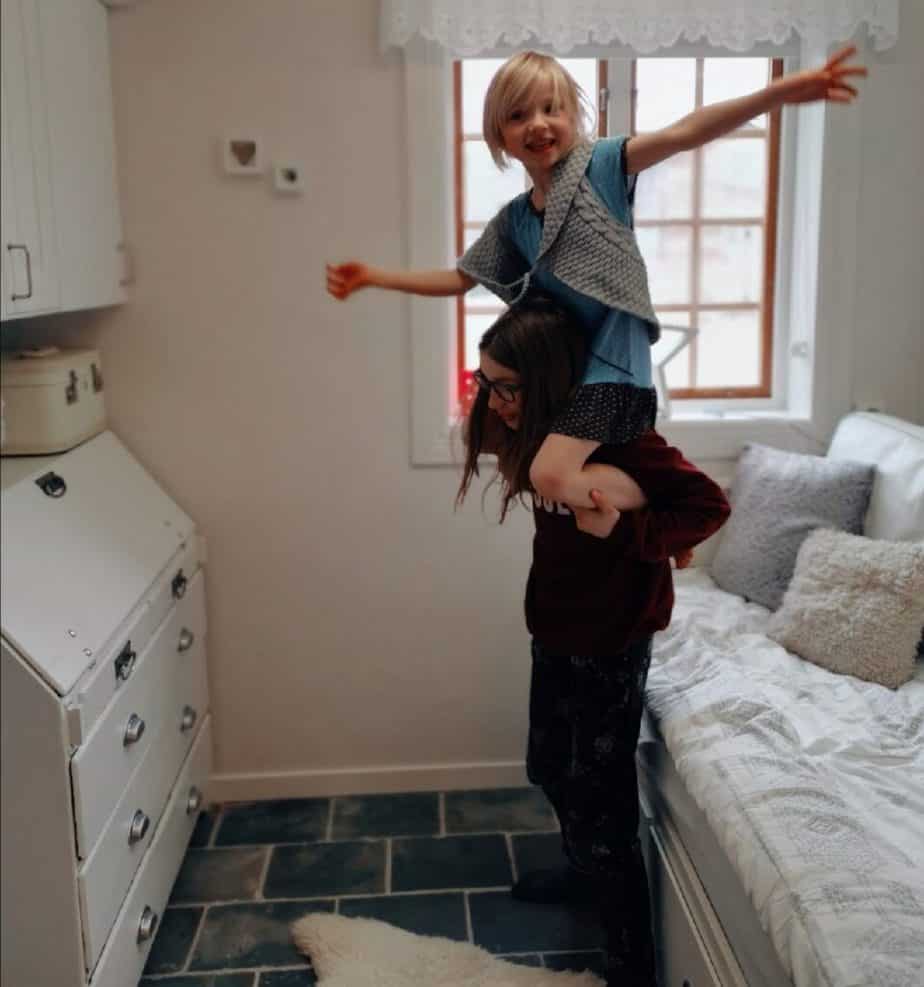
Choice of materials for a safe toxin free kids bedroom
You may want to check your child’s room for lead paint if you live in a house built before the end of the 70s in the USA or before the 30s in Sweden.
Paint chips from an old paint can turn into toxic dust in the house or toxic soil from peeling paint outside.
If you’re in doubt, get an expert to take samples for a lab to analyze.
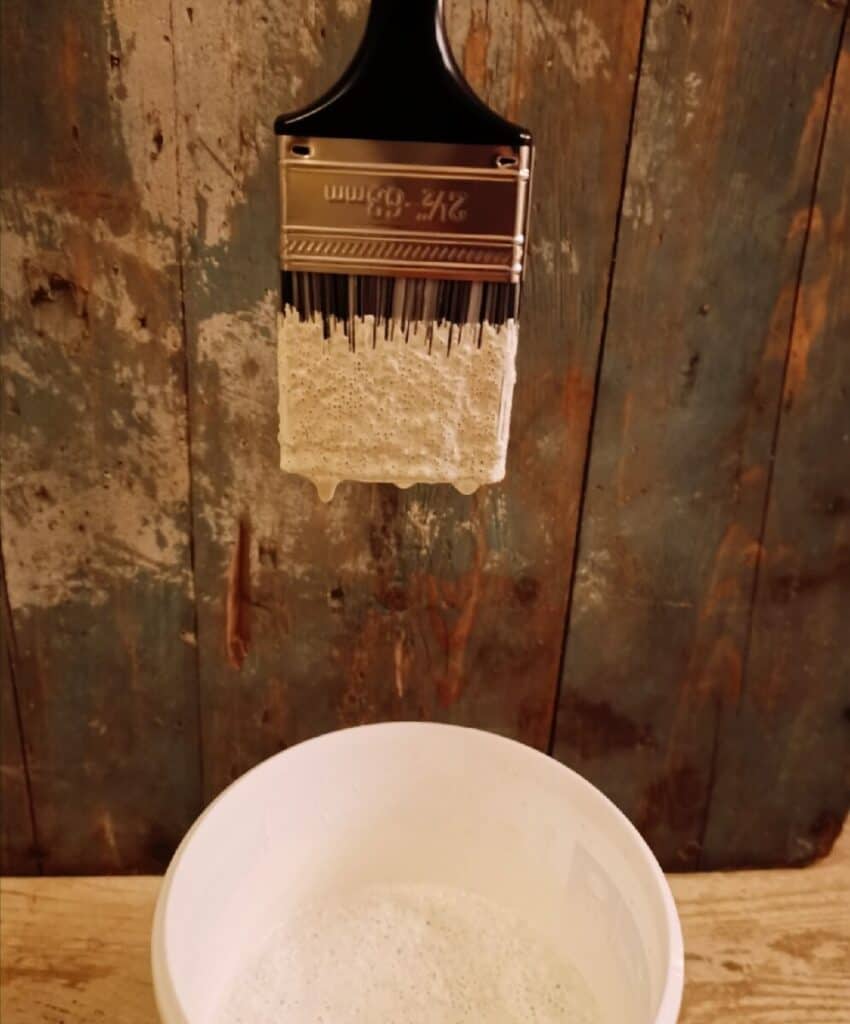
Use toxin free Paint in kids rooms
I decided to avoid the toxins in regular paint, by mixing my own egg paint. I ordered a creme-colored pigment and followed the instructions on how to mix the paint.
It’s not hard to mix organic paints. Once you have done it a couple of times it won’t take you hardly any time at all.
Since lead paint can contribute to increased ADHD symptoms and two of my children have ADHD I feel much better knowing that my five-year-old can literally lick the walls without ingesting any toxins.
Studies done in South Africa found that half of the homes they tested still had lead paint on the walls.
Unexpecting people were still being sold lead paint just a few
years ago, and lead paint is probably still on the shelves of South African home decorating stores!
It was thanks to a little girl who ate paint chips that the lead was discovered at all. If you live in a country where there are not strictly enforced rules for products that contain lead.
Do yourself a favor and buy powdered paint pigment and make your own safe paint.
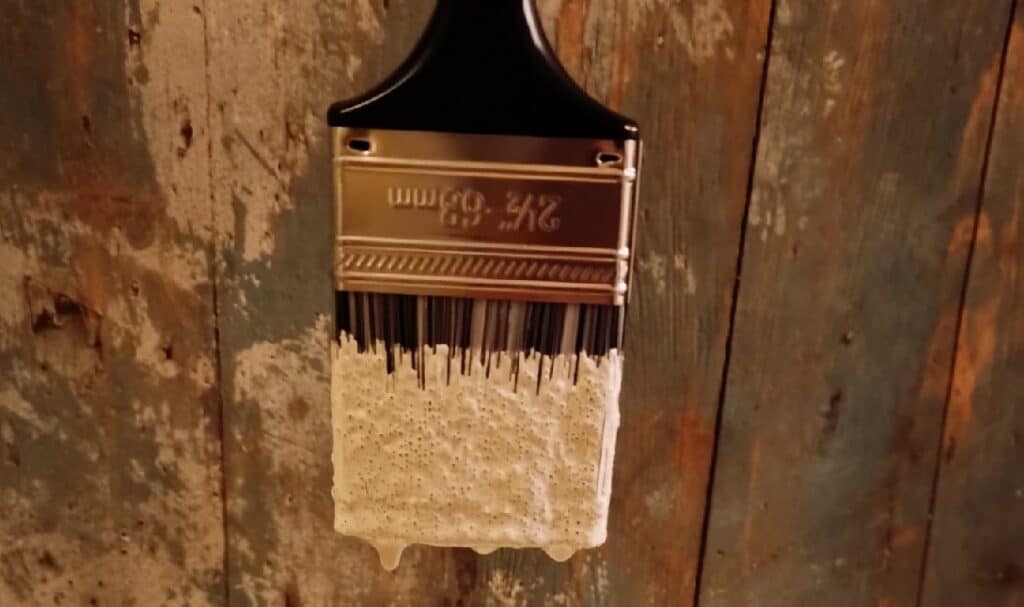
If you want to make your own egg tempera paint, you can read my illustrerad guide. click below.
https://theadhdminimalist.com/a-helpful-illustrerad-guide-for-making-organic-egg-paint/
If you have questions about egg tempera you can read the answers to the most common questions below.
https://theadhdminimalist.com/the-most-common-questions-about-toxin-free-egg-paint-q-and-a/
Sources
Below is a link to an article listing what countries still sell decorative paint containing lead.
https://www.ncbi.nlm.nih.gov/pmc/articles/PMC3983718/
https://journals.sagepub.com/doi/abs/10.1177/0956797615618365
https://pubmed.ncbi.nlm.nih.gov/26710823/
https://www.epa.gov/lead/learn-about-lead
https://academic.oup.com/brain/article/126/1/5/299373
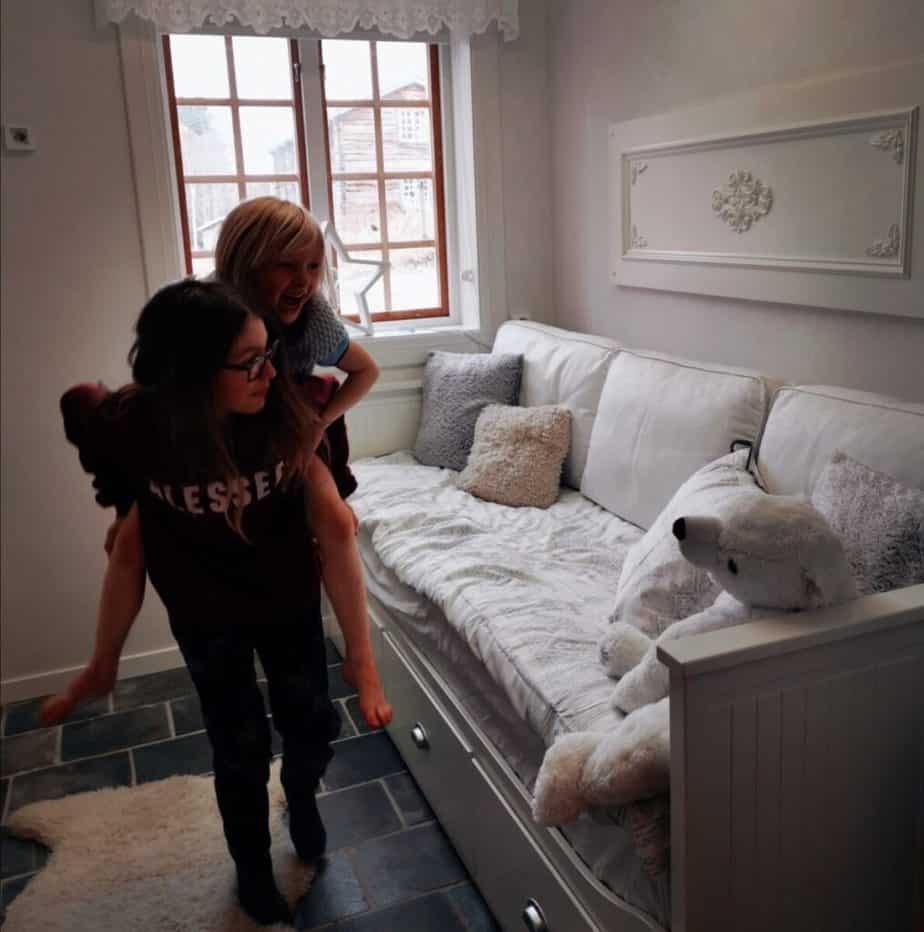
Wash any new textiles before use, buy used or organic textiles
Textiles which are not organic contain toxins and chemicals. Wash new textiles twice before letting your child sleep with them if they are not certified organic.
Buying organic textiles is a way to avoid unwanted chemicals altogether, but sometimes organic products cost more than our budget allows.
Keep an eye out for used textiles at garage sales. Sometimes you can find something you really like for a few bucks.
Used textiles have often been washed many times and any chemicals originally in the fabric are long gone.
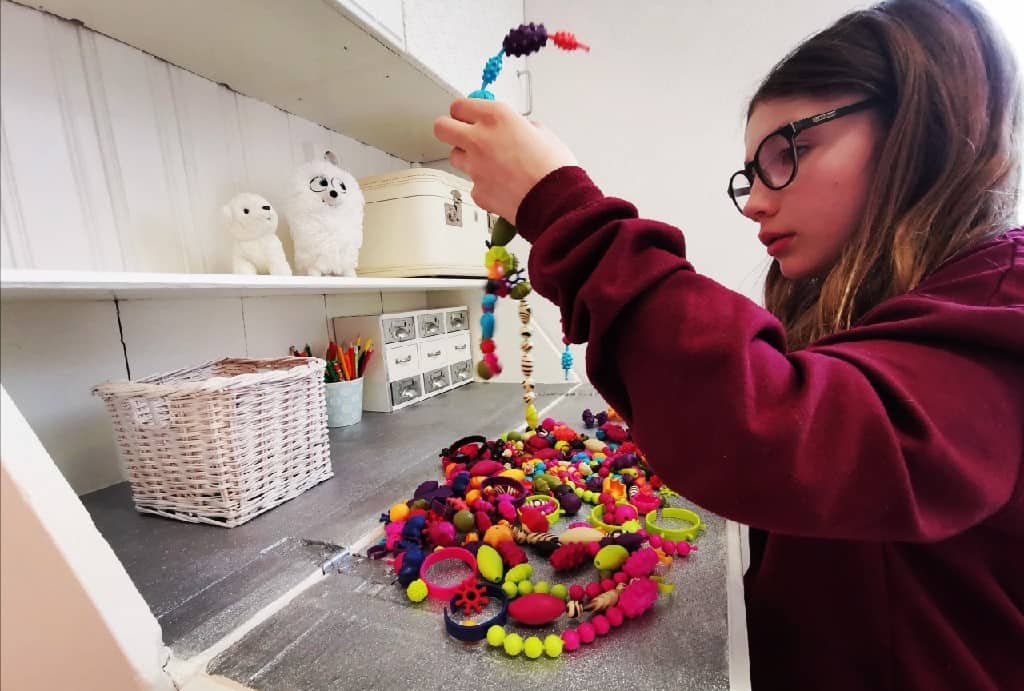
I hope you found some inspiration for your redecorating projects.
If you need a quick fix for your child’s room and don’t have time to completely redecorate click below for all the help you need to declutter and reorganize your child’s room. https://theadhdminimalist.com/help-adhd-add-kids-clean-their-rooms-and-stay-organized/
For more information and more book tips check out our page Our Favorite Resources. https://theadhdminimalist.com/our-favourite-resources/
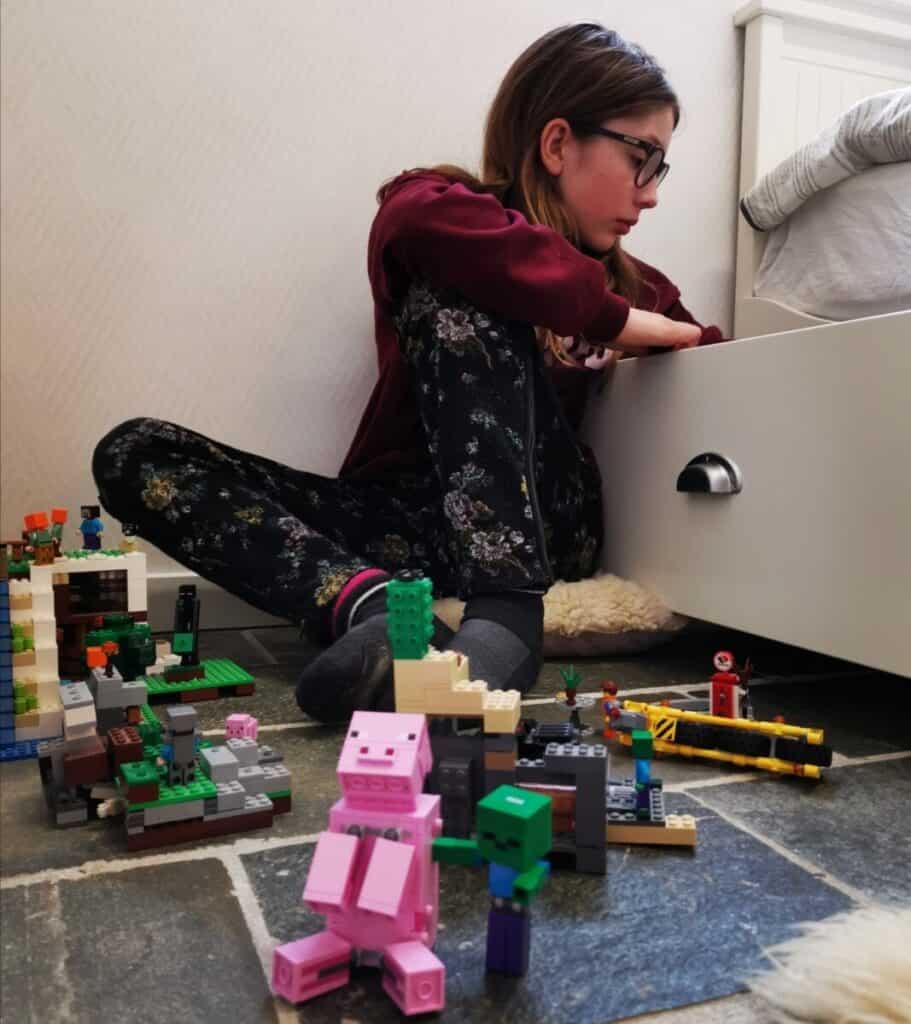
copyright Annie Eklöv



